Leadership Models and Theories Analysis: A Case Study on Steve Jobs
VerifiedAdded on 2022/10/08
|6
|1226
|15
Essay
AI Summary
This essay provides a detailed overview of various leadership models and theories, including trait theory, behavioral theory, contingency theory, transactional leadership, transformational leadership, and situational leadership. The paper emphasizes the significance of understanding these theories for business growth. The leadership style of Steve Jobs, the founder of Apple Inc., is analyzed as a case study, highlighting his vision, innovation, and ability to understand employee and stakeholder needs. The essay also includes a personal analysis of the author's leadership capabilities, such as communication skills, integrity, and a commitment to continuous learning. The conclusion reiterates the importance of leadership in organizational success and the value of learning from role models like Steve Jobs.
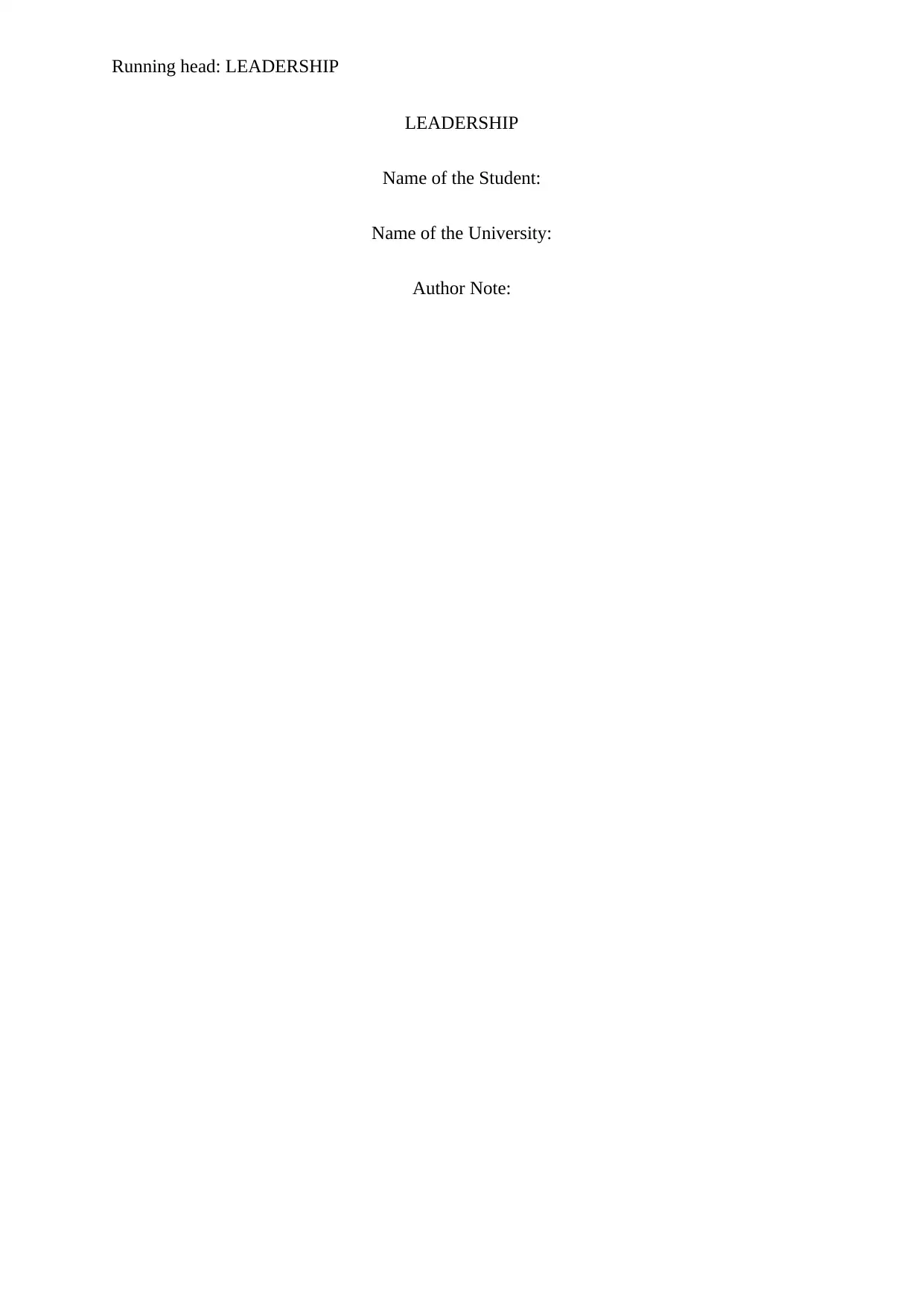
Running head: LEADERSHIP
LEADERSHIP
Name of the Student:
Name of the University:
Author Note:
LEADERSHIP
Name of the Student:
Name of the University:
Author Note:
Paraphrase This Document
Need a fresh take? Get an instant paraphrase of this document with our AI Paraphraser
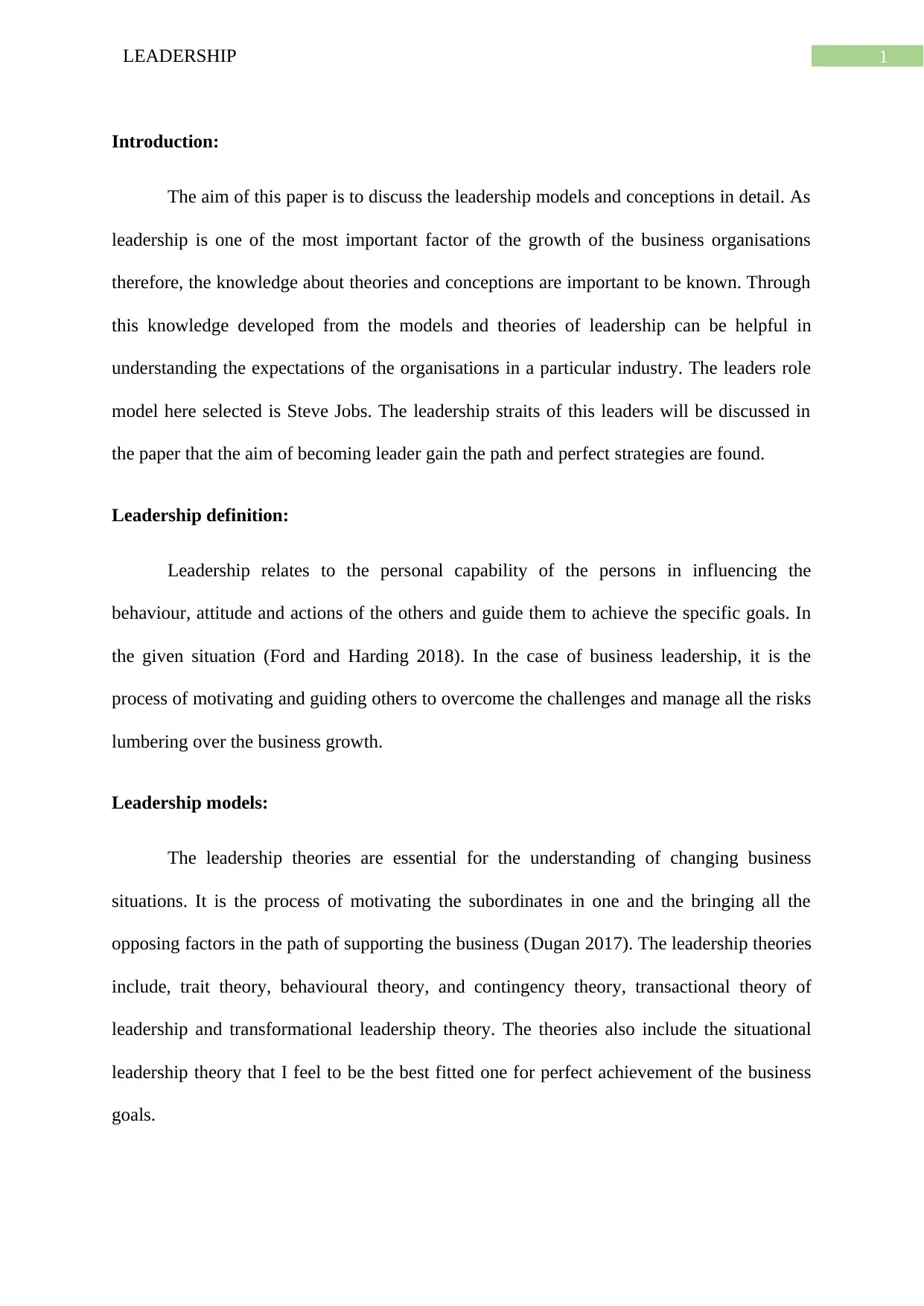
1LEADERSHIP
Introduction:
The aim of this paper is to discuss the leadership models and conceptions in detail. As
leadership is one of the most important factor of the growth of the business organisations
therefore, the knowledge about theories and conceptions are important to be known. Through
this knowledge developed from the models and theories of leadership can be helpful in
understanding the expectations of the organisations in a particular industry. The leaders role
model here selected is Steve Jobs. The leadership straits of this leaders will be discussed in
the paper that the aim of becoming leader gain the path and perfect strategies are found.
Leadership definition:
Leadership relates to the personal capability of the persons in influencing the
behaviour, attitude and actions of the others and guide them to achieve the specific goals. In
the given situation (Ford and Harding 2018). In the case of business leadership, it is the
process of motivating and guiding others to overcome the challenges and manage all the risks
lumbering over the business growth.
Leadership models:
The leadership theories are essential for the understanding of changing business
situations. It is the process of motivating the subordinates in one and the bringing all the
opposing factors in the path of supporting the business (Dugan 2017). The leadership theories
include, trait theory, behavioural theory, and contingency theory, transactional theory of
leadership and transformational leadership theory. The theories also include the situational
leadership theory that I feel to be the best fitted one for perfect achievement of the business
goals.
Introduction:
The aim of this paper is to discuss the leadership models and conceptions in detail. As
leadership is one of the most important factor of the growth of the business organisations
therefore, the knowledge about theories and conceptions are important to be known. Through
this knowledge developed from the models and theories of leadership can be helpful in
understanding the expectations of the organisations in a particular industry. The leaders role
model here selected is Steve Jobs. The leadership straits of this leaders will be discussed in
the paper that the aim of becoming leader gain the path and perfect strategies are found.
Leadership definition:
Leadership relates to the personal capability of the persons in influencing the
behaviour, attitude and actions of the others and guide them to achieve the specific goals. In
the given situation (Ford and Harding 2018). In the case of business leadership, it is the
process of motivating and guiding others to overcome the challenges and manage all the risks
lumbering over the business growth.
Leadership models:
The leadership theories are essential for the understanding of changing business
situations. It is the process of motivating the subordinates in one and the bringing all the
opposing factors in the path of supporting the business (Dugan 2017). The leadership theories
include, trait theory, behavioural theory, and contingency theory, transactional theory of
leadership and transformational leadership theory. The theories also include the situational
leadership theory that I feel to be the best fitted one for perfect achievement of the business
goals.
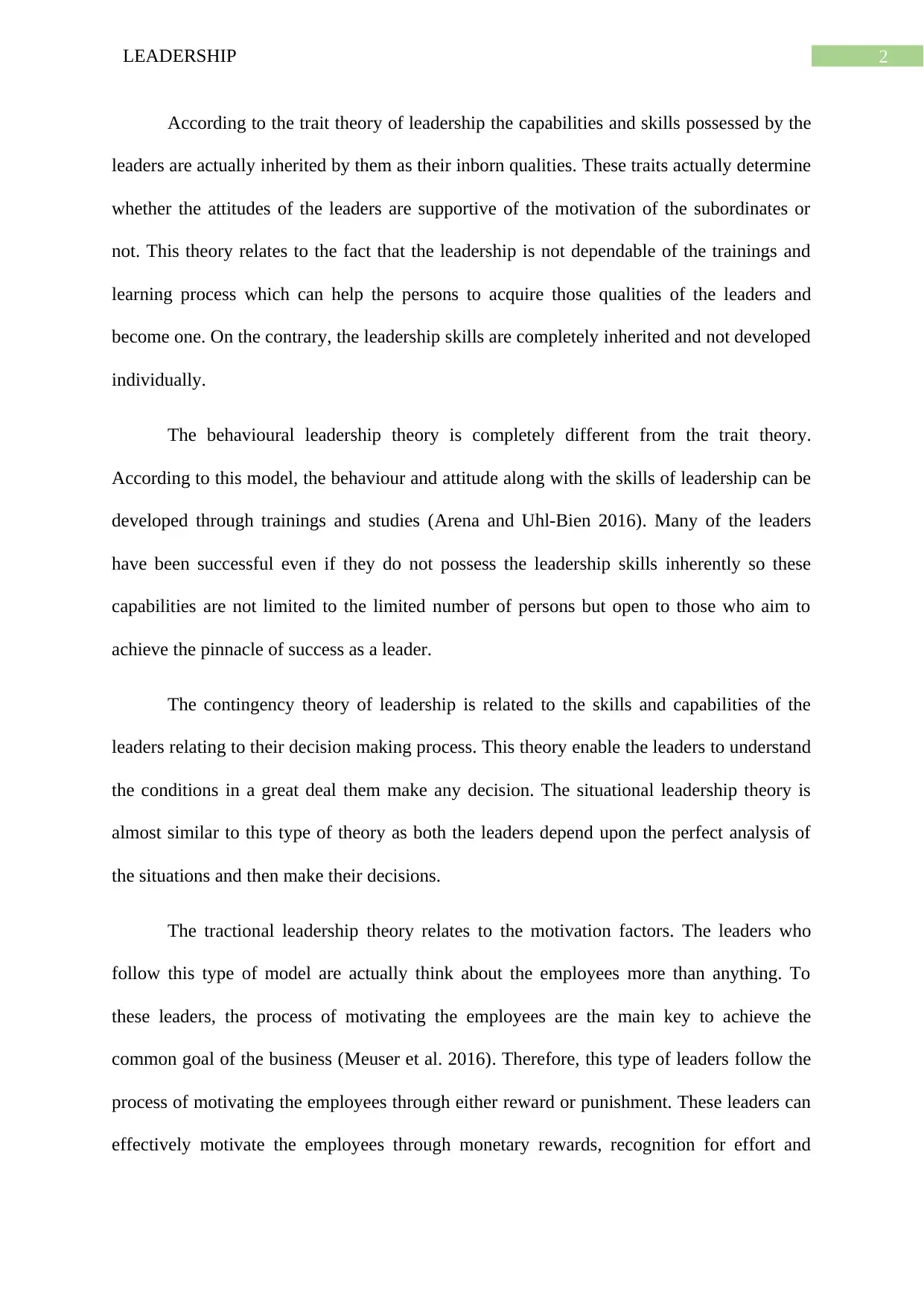
2LEADERSHIP
According to the trait theory of leadership the capabilities and skills possessed by the
leaders are actually inherited by them as their inborn qualities. These traits actually determine
whether the attitudes of the leaders are supportive of the motivation of the subordinates or
not. This theory relates to the fact that the leadership is not dependable of the trainings and
learning process which can help the persons to acquire those qualities of the leaders and
become one. On the contrary, the leadership skills are completely inherited and not developed
individually.
The behavioural leadership theory is completely different from the trait theory.
According to this model, the behaviour and attitude along with the skills of leadership can be
developed through trainings and studies (Arena and Uhl-Bien 2016). Many of the leaders
have been successful even if they do not possess the leadership skills inherently so these
capabilities are not limited to the limited number of persons but open to those who aim to
achieve the pinnacle of success as a leader.
The contingency theory of leadership is related to the skills and capabilities of the
leaders relating to their decision making process. This theory enable the leaders to understand
the conditions in a great deal them make any decision. The situational leadership theory is
almost similar to this type of theory as both the leaders depend upon the perfect analysis of
the situations and then make their decisions.
The tractional leadership theory relates to the motivation factors. The leaders who
follow this type of model are actually think about the employees more than anything. To
these leaders, the process of motivating the employees are the main key to achieve the
common goal of the business (Meuser et al. 2016). Therefore, this type of leaders follow the
process of motivating the employees through either reward or punishment. These leaders can
effectively motivate the employees through monetary rewards, recognition for effort and
According to the trait theory of leadership the capabilities and skills possessed by the
leaders are actually inherited by them as their inborn qualities. These traits actually determine
whether the attitudes of the leaders are supportive of the motivation of the subordinates or
not. This theory relates to the fact that the leadership is not dependable of the trainings and
learning process which can help the persons to acquire those qualities of the leaders and
become one. On the contrary, the leadership skills are completely inherited and not developed
individually.
The behavioural leadership theory is completely different from the trait theory.
According to this model, the behaviour and attitude along with the skills of leadership can be
developed through trainings and studies (Arena and Uhl-Bien 2016). Many of the leaders
have been successful even if they do not possess the leadership skills inherently so these
capabilities are not limited to the limited number of persons but open to those who aim to
achieve the pinnacle of success as a leader.
The contingency theory of leadership is related to the skills and capabilities of the
leaders relating to their decision making process. This theory enable the leaders to understand
the conditions in a great deal them make any decision. The situational leadership theory is
almost similar to this type of theory as both the leaders depend upon the perfect analysis of
the situations and then make their decisions.
The tractional leadership theory relates to the motivation factors. The leaders who
follow this type of model are actually think about the employees more than anything. To
these leaders, the process of motivating the employees are the main key to achieve the
common goal of the business (Meuser et al. 2016). Therefore, this type of leaders follow the
process of motivating the employees through either reward or punishment. These leaders can
effectively motivate the employees through monetary rewards, recognition for effort and
⊘ This is a preview!⊘
Do you want full access?
Subscribe today to unlock all pages.

Trusted by 1+ million students worldwide
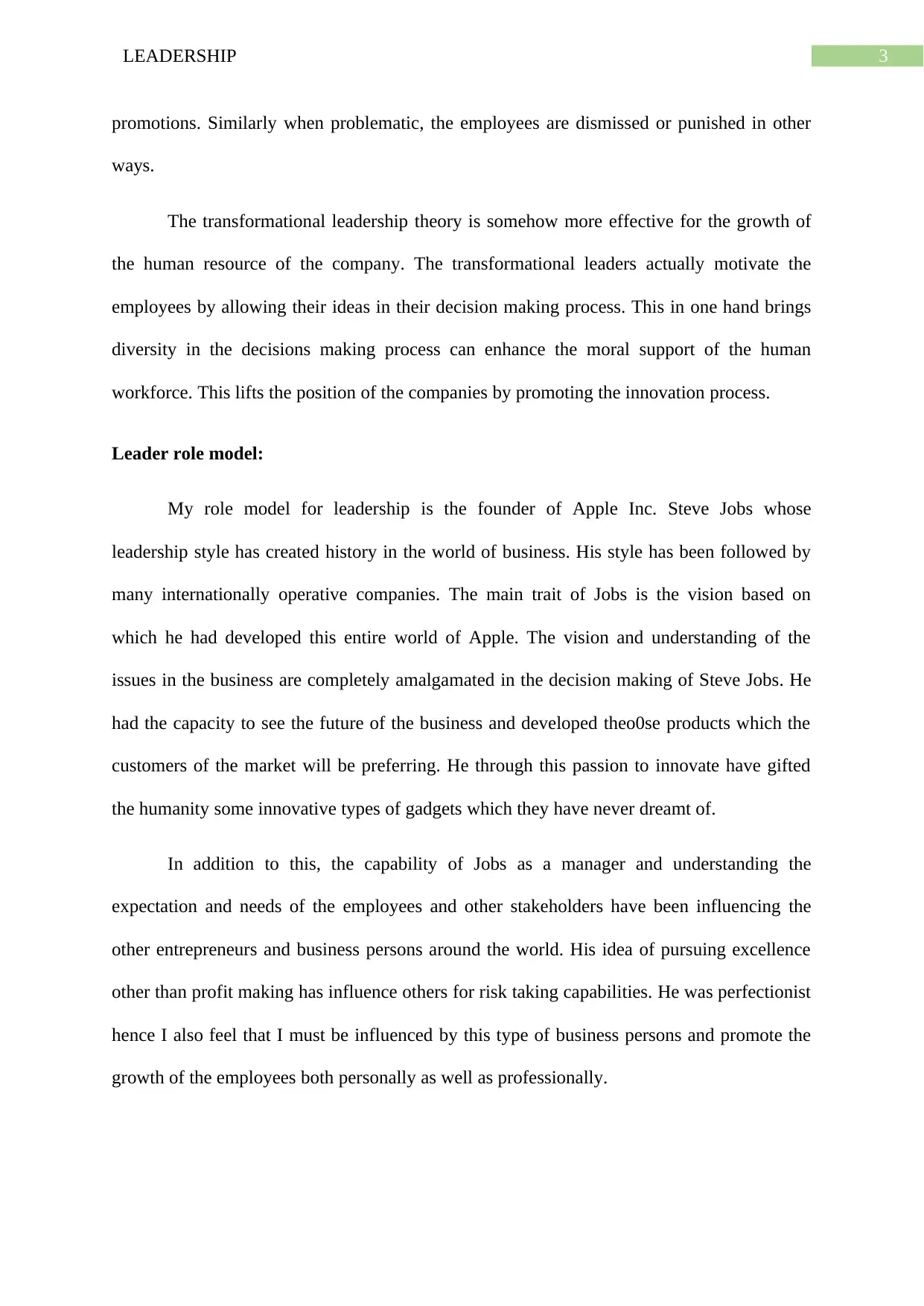
3LEADERSHIP
promotions. Similarly when problematic, the employees are dismissed or punished in other
ways.
The transformational leadership theory is somehow more effective for the growth of
the human resource of the company. The transformational leaders actually motivate the
employees by allowing their ideas in their decision making process. This in one hand brings
diversity in the decisions making process can enhance the moral support of the human
workforce. This lifts the position of the companies by promoting the innovation process.
Leader role model:
My role model for leadership is the founder of Apple Inc. Steve Jobs whose
leadership style has created history in the world of business. His style has been followed by
many internationally operative companies. The main trait of Jobs is the vision based on
which he had developed this entire world of Apple. The vision and understanding of the
issues in the business are completely amalgamated in the decision making of Steve Jobs. He
had the capacity to see the future of the business and developed theo0se products which the
customers of the market will be preferring. He through this passion to innovate have gifted
the humanity some innovative types of gadgets which they have never dreamt of.
In addition to this, the capability of Jobs as a manager and understanding the
expectation and needs of the employees and other stakeholders have been influencing the
other entrepreneurs and business persons around the world. His idea of pursuing excellence
other than profit making has influence others for risk taking capabilities. He was perfectionist
hence I also feel that I must be influenced by this type of business persons and promote the
growth of the employees both personally as well as professionally.
promotions. Similarly when problematic, the employees are dismissed or punished in other
ways.
The transformational leadership theory is somehow more effective for the growth of
the human resource of the company. The transformational leaders actually motivate the
employees by allowing their ideas in their decision making process. This in one hand brings
diversity in the decisions making process can enhance the moral support of the human
workforce. This lifts the position of the companies by promoting the innovation process.
Leader role model:
My role model for leadership is the founder of Apple Inc. Steve Jobs whose
leadership style has created history in the world of business. His style has been followed by
many internationally operative companies. The main trait of Jobs is the vision based on
which he had developed this entire world of Apple. The vision and understanding of the
issues in the business are completely amalgamated in the decision making of Steve Jobs. He
had the capacity to see the future of the business and developed theo0se products which the
customers of the market will be preferring. He through this passion to innovate have gifted
the humanity some innovative types of gadgets which they have never dreamt of.
In addition to this, the capability of Jobs as a manager and understanding the
expectation and needs of the employees and other stakeholders have been influencing the
other entrepreneurs and business persons around the world. His idea of pursuing excellence
other than profit making has influence others for risk taking capabilities. He was perfectionist
hence I also feel that I must be influenced by this type of business persons and promote the
growth of the employees both personally as well as professionally.
Paraphrase This Document
Need a fresh take? Get an instant paraphrase of this document with our AI Paraphraser
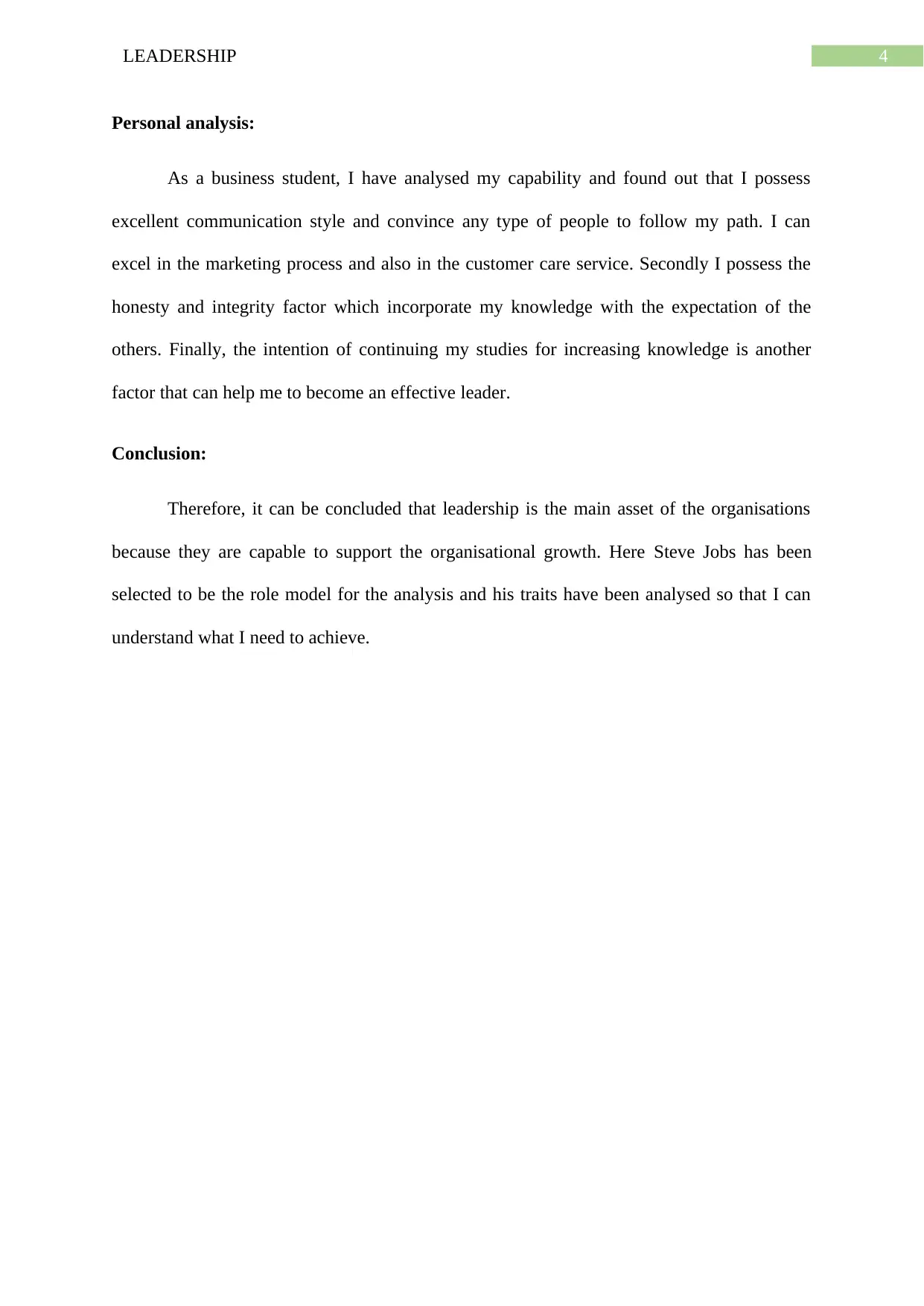
4LEADERSHIP
Personal analysis:
As a business student, I have analysed my capability and found out that I possess
excellent communication style and convince any type of people to follow my path. I can
excel in the marketing process and also in the customer care service. Secondly I possess the
honesty and integrity factor which incorporate my knowledge with the expectation of the
others. Finally, the intention of continuing my studies for increasing knowledge is another
factor that can help me to become an effective leader.
Conclusion:
Therefore, it can be concluded that leadership is the main asset of the organisations
because they are capable to support the organisational growth. Here Steve Jobs has been
selected to be the role model for the analysis and his traits have been analysed so that I can
understand what I need to achieve.
Personal analysis:
As a business student, I have analysed my capability and found out that I possess
excellent communication style and convince any type of people to follow my path. I can
excel in the marketing process and also in the customer care service. Secondly I possess the
honesty and integrity factor which incorporate my knowledge with the expectation of the
others. Finally, the intention of continuing my studies for increasing knowledge is another
factor that can help me to become an effective leader.
Conclusion:
Therefore, it can be concluded that leadership is the main asset of the organisations
because they are capable to support the organisational growth. Here Steve Jobs has been
selected to be the role model for the analysis and his traits have been analysed so that I can
understand what I need to achieve.
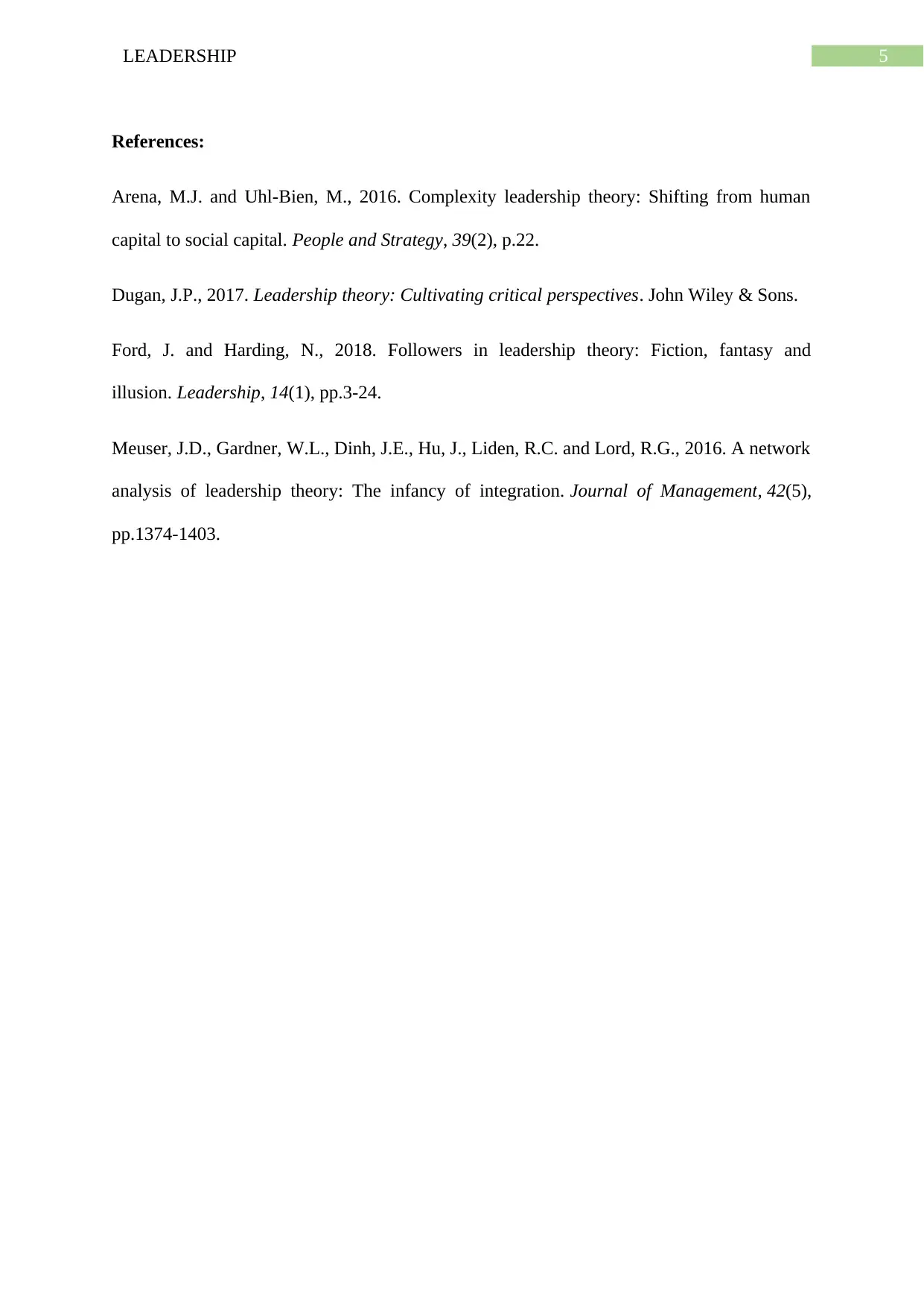
5LEADERSHIP
References:
Arena, M.J. and Uhl-Bien, M., 2016. Complexity leadership theory: Shifting from human
capital to social capital. People and Strategy, 39(2), p.22.
Dugan, J.P., 2017. Leadership theory: Cultivating critical perspectives. John Wiley & Sons.
Ford, J. and Harding, N., 2018. Followers in leadership theory: Fiction, fantasy and
illusion. Leadership, 14(1), pp.3-24.
Meuser, J.D., Gardner, W.L., Dinh, J.E., Hu, J., Liden, R.C. and Lord, R.G., 2016. A network
analysis of leadership theory: The infancy of integration. Journal of Management, 42(5),
pp.1374-1403.
References:
Arena, M.J. and Uhl-Bien, M., 2016. Complexity leadership theory: Shifting from human
capital to social capital. People and Strategy, 39(2), p.22.
Dugan, J.P., 2017. Leadership theory: Cultivating critical perspectives. John Wiley & Sons.
Ford, J. and Harding, N., 2018. Followers in leadership theory: Fiction, fantasy and
illusion. Leadership, 14(1), pp.3-24.
Meuser, J.D., Gardner, W.L., Dinh, J.E., Hu, J., Liden, R.C. and Lord, R.G., 2016. A network
analysis of leadership theory: The infancy of integration. Journal of Management, 42(5),
pp.1374-1403.
⊘ This is a preview!⊘
Do you want full access?
Subscribe today to unlock all pages.

Trusted by 1+ million students worldwide
1 out of 6
Related Documents
Your All-in-One AI-Powered Toolkit for Academic Success.
+13062052269
info@desklib.com
Available 24*7 on WhatsApp / Email
![[object Object]](/_next/static/media/star-bottom.7253800d.svg)
Unlock your academic potential
Copyright © 2020–2025 A2Z Services. All Rights Reserved. Developed and managed by ZUCOL.




